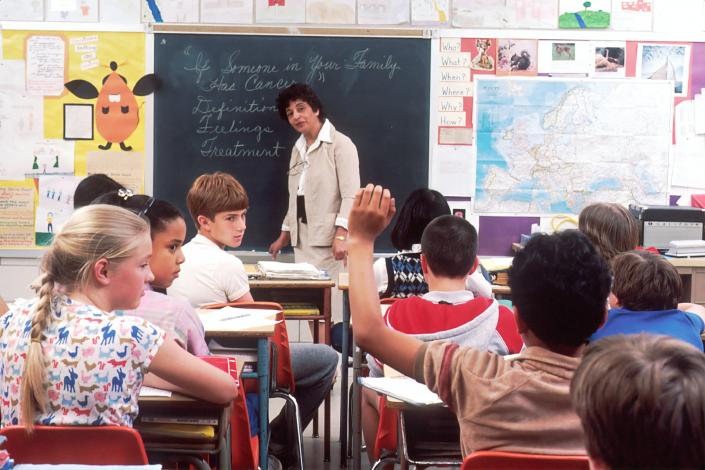What to do about school this year?
This post contains references to products from one or more of our advertisers. We may receive compensation when you click on links to those products. Terms apply to the offers listed on this page. For an explanation of our Advertising Policy, visit this page.
Many parents are faced with a tough choice this coming fall. Send your child back to school or homeschool them?
School districts continue to make plans for this upcoming school year, and parents everywhere are confused, frustrated, and unsure of how to react. There are many parents that are blaming schools for not opening up fully while others are saying that no kids should go to school this year. There are others (such as myself) that are just unsure what this school year is really going to look like.
As is common on the internet, everyone is ready to throw their own opinion out there as if it’s the only correct decision that can be made. As is wise, it would be far better off if we could all take a step back for a moment, take a breath, and look at the situation logically - remove emotion from the equation for a moment.
No matter what decision is made for this upcoming school year by your district, it’s going to upset some parents. There is no perfect solution that can be implemented in six months of time that will solve the problem that we are facing this upcoming school year (if we had started planning near the end of march, that's about what we'd have had). The problems that need to be solved will require innovative solutions that take time to implement. Furthermore, these solutions will likely require policy change at the national and state levels.
I’d like to take a step back though, and look at the current solutions that are starting to be proposed by school districts across the country, discuss their impact beyond just parents, and look at why all of the solutions are problematic in some way. This will hopefully help to set a framework for starting to find real solutions to the problems we’re facing (although the solutions won't be presented in this article).
There are a few parties that are affected most by school this year. We’ll look at each solution and how each party is affected. The primary parties: kids, parents/family, teachers/school staff, employers/economy. Any solution that is presented needs to look at how each of these parties are affected and interplay with each other.
Go back to full time school schedule
In normal times, this is easily the best solution. While there are certainly issues with our standard education system, this is the least disruptive option to each of the parties...in normal times. However, with the current pandemic really heating up here in the United States, this is likely going to be a devastating decision.
Child
This is probably the easiest solution for kids, especially those in grade school. The virus generally doesn’t affect younger kids (yes, it still can but it’s far less common). Most kids learn better in a dedicated environment being taught by a trained teacher. They’ll also be able to interact with other kids socially, and most of the education system has been set up to work in this environment. Classes that require hands on experience are easier to implement.
For older kids, this solution may not be as ideal as it’s easier for them to get sick. Beyond the possibility of dying (which is obviously the worst outcome), we also don’t know the full long term effects of the virus. Sending kids back to school seems like a live experiment where we'll learn over the coming years what effects there are.
Parent/Family
The good for parents - they can continue to work as they previously did. They don’t have to try to balance teaching kids and working, which is pretty tough to do, especially when your kids aren't self motivated to learn.
The downside to parents is that they’ll be far more exposed to the virus. While working adults are generally pretty good about social distancing and keeping things clean, kids are not. While kids aren’t super likely to get sick, adults are. Having kids at school all day where they’ll be exposed to hundreds of other kids is going to lead to a lot of parents getting sick. Once sick, they’ll be stuck at home for a 2-week quarantine period along with their child (you should absolutely not let a kid in the school that has an active COVID-19 case at home).
Teacher
Every solution for teachers is a tough one, and this is no exception, However, see the last section for the worst solution for teachers. The good of this solution is that teachers will be able to continue to teach as they always have taught - in person lessons.
However, like parents, teachers are much more likely to get sick, and their exposure will be much higher than that of parents. Teachers will be in an environment everyday where they will be highly exposed, and they don’t really have a good solution to stay safe. PPE will help, but it won’t be the full solution. Furthermore, many teachers are older and thus higher risk. Many of these older teachers are retiring early, and many younger teachers are leaving as well because they don’t have the protection that they need. Teachers are often parents, and they are thinking about their own well being, and those of their loved ones. The fewer teachers we have in the schools, the less effective the return to school will be.
Another major problem for teachers is what happens when they get sick. You’ll need a substitute teacher, obviously, but they have the same concerns as teachers. Similarly, many are choosing not to substitute this year because of the dangers involved.
Economy
While this seems to be the driving factor for reopening schools full time, it seems that it may have far bigger negative impacts that are not being considered. For employers, it seems like they’re going to have their employees working again with less distractions at home. This should lead to more productivity.
However, that only works if teachers and students return to school full time, and there are no outbreaks of the virus in schools, and kids of your employees don’t get sick, and parents continue to send their kids to school, and so on and so forth. While the assumption is nice, it is not based in reality.
Kids and parents will get sick, which means employees will be off, working from home, or being forced to work and spreading the virus to others (plenty of terrible employers out there, unfortunately).
Many parents are going to choose to not send their kids back to school this fall which means that many employees will be leaving jobs. For some, they may be making this decision even though they are not in a financial position to do so - the further negative impacts on the economy are yet to be seen, but I expect plenty of people either defaulting on loans, missing rent/utility payments, or moving to smaller and more affordable homes.
People that are screaming that parents should homeschool their kids if they don’t want to send them to school have to realize that you can’t completely fix a financial situation where you’re dependent on two incomes at the drop of a hat. The inner-workings of how all of this will affect the economy are yet to be seen, but there will be some negative effect.
Fully online school schedule
This is what was being done at the end of the 2019-2020 school year. All distance learning. This is by far the safest solution, but it also has the biggest negative impacts on basically everything else.
Child
This is an extremely tough solution for kids. While some kids thrive in an online learning environment, many do not. Learning online requires discipline to focus and motivation to stay on top of learning. If you’re able to do that, then online learning can be extremely effective. Most younger kids have not learned this ability yet.
Furthermore, many of the resources for younger children are simply not great in an online environment. There are tools available, but your district will have to pay for them, and a lot of districts don’t have the money to do so. Ultimately, younger children will be left well behind with a fully online education.
Parent/Family
If you’re already a stay at home parent, this adds work to your job, but it’s much easier to take on. Many stay at home parents are already planning to take their kids out of school this year to do online or homeschool anyways for safety reasons. If you have this ability, then it’s a valid decision. If you’ve never taught before, it will require a lot of time to do it effectively - be prepared to invest plenty of time into your child’s learning.
For working parents, there are two different sides to this. Some parents can work from home (and you’re really grateful for that option), but the productivity is extremely low. Trying to work and teach a student is tough. If your child is old enough to do their own work, and they are motivated enough to do it, then you’re lucky. Most parents have to invest time in keeping their kids on task and learning.
If your employer doesn’t allow working remotely, then you’re likely going to have to leave your job. There aren’t really any other options available. This is why many parents are screaming for a return to full time regular school. The loss of a job long term will be devastating for many families.
Teacher
This is the safest solution for teachers. They won’t be exposed to hundreds of kids everyday, and they can continue to teach. This is the best solution for them.
However, many teachers are not great at teaching online. This requires additional support to help teachers who are not comfortable in an online learning environment. Preparing lessons and assignments for online work is very different from preparing it for classroom work.
Teachers are also far less effective getting through to the kids in an online environment. Not seeing someone face to face makes it difficult to know how a child is learning. Even with technology to help, many kids avoid showing their face or have lower participation. It’s simply harder for a teacher to be as effective if the child is not motivated.
Economy
Fully online education will likely be the most devastating option for employers and the economy. Employers are going to have to allow their employees to work from home, or else they will have to reduce their workforce.
Employees working from home can be just as productive, if not more productive, than those that work in the office. However, that’s assuming that those employees are able to focus on work, and not trying to teach kids at home at the same time which would be the case here. Productivity will be down from parents working from home due to their kids also being at home.
Companies will likely feel the negative effects one way or another from parents having to work from home or by reducing their staff. There’s not a perfect solution here for employers.
Hybrid school schedule
Combining the two solutions above is going to be toughest for teachers, and it’s unclear how effective they will be in keeping everyone safe. If they are effective, this could be the best solution for others, but it’s also possible that it may look like a good solution when in reality it may make no difference.
Child
Kids are less exposed to the virus as they’ll be in smaller classroom sizes, and less kids in the school. They’ll be able to interact with their peers. They’ll be able to do assignments and experiments in person, and work on the things that require less interaction at home.
This certainly seems like the best option for kids all around. As long as the spread of the virus is actually slowed with this model, then this is the best model for them.
Parent/Family
Once again, we’ll assume that the spread of the virus is actually slowed in this model - less sickness and thus less deaths. Taking work out of the equation for a minute, this is also the best option for parents. Kids are being taught in the classroom the things that are really tough to do at home, and then you can use the online tools on the days and times that your child is at home.
Putting work back into the scenario, it’s certainly easier than a fully at home schedule. Hopefully your employer can be more flexible in this scenario. If not, you may be able to move to a part time position since you won’t be required to be at home with your child full time. Loss of income could still be a real problem, but ideally the negative impact is lessened in this model.
Teacher
This by far the worst solution for teachers. They easily get the worst of everything in this model. They will still be exposed to the virus, although to a lesser extent than in a regular school schedule model. While getting sick is lessened, the amount of work that will be required of them is unprecedented.
We’ll be asking teachers to prepare in classroom lessons, be with the kids in those lessons all day, and then also find time to prepare online lessons and resources. Teachers don’t simply have their lesson content handed to them - they prepare it all. Having to prepare lessons for two different modes of teaching will make it quite difficult for them to accomplish.
If teachers are able to find tools and resources that are assigned for kids on the off days that don’t require the teacher to do a lot of planning, then this can be successful. However, many districts don’t have those tools available, and they won’t have the budget to pay for them.
Economy
Better than a full time online schedule, and worse than a full time in person schedule. The good and bad of the previous two sections merge here. Once again, assuming that this method does actually slow the spread of the virus, it will actually have a bigger positive impact over the course of the school year than a full reopen. The reason for that is that we won’t have to have school shutdowns as will invariably come as part of a full reopen. This means that more parents can keep working and working effectively, even if a few days a week they are distracted with teaching their kids.
Conclusion
Finding a solution to the education problem that we’re facing this school year is not simple. There are many factors to consider beyond just children learning. We need to take a step back and make sure our approach makes sense for as many of the people involved that we can. Now is not the time to complain about the issues, but rather to look at them objectively and begin to figure out better solutions in the long term for how learning works in our day and age.
Comments
I'm keeping my kids home…
I'm keeping my kids home this year. I'm lucky that I can.





